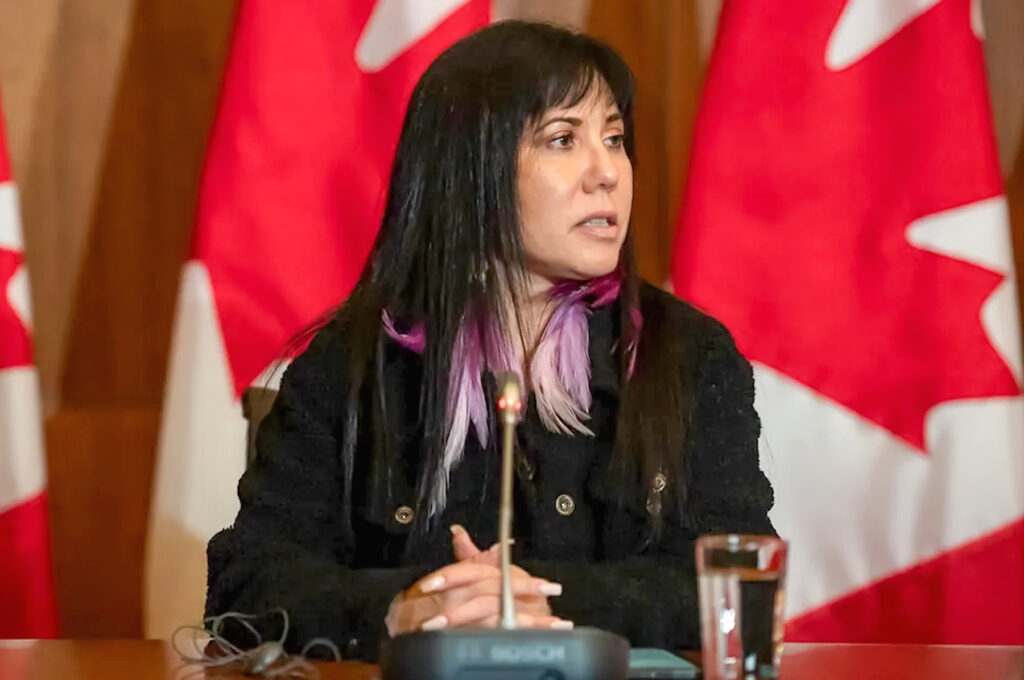
A Manitoba MP is trying to create an alert system to notify the public when Indigenous women go missing — an endeavour she hopes will lead to fewer deaths and more safe reunions with loved ones.
“This is a critical initiative,” New Democrat MP Leah Gazan, who represents the riding of Winnipeg Centre, said last month as a House of Commons committee began studying her “Red Dress Alert” proposal.
“This is an initiative that will save lives.”
Gazan’s fellow MPs unanimously backed her motion last year declaring the deaths and disappearances of Indigenous women and girls a Canada-wide emergency. The motion also called for funding for a new alert system similar to those that exist for missing children and seniors.
Now, MPs are discussing with experts and stakeholders about how to implement such a system across the country.
A 2019 report from a national inquiry into missing and murdered Indigenous women and girls found deliberate rights violations at the heart of violence against Indigenous women, girls and gender-diverse people.
With the final report came 231 calls to justice directed toward governments, social service providers, industry and Canadians, but relatively little progress has been made to date — particularly on the federal side.
Between 2009 and 2021, the homicide rate among Indigenous women and girls was six times higher than for their non-Indigenous counterparts, Statistics Canada concluded in a report released last year.
That report also found that homicides involving Indigenous women and girls are less likely to result in the most serious murder charges than cases in which victims were non-Indigenous.
Sheila North, former grand chief of Manitoba Keewatinowi Okimakanak and an ex-journalist, said she frequently encountered examples of police inaction when reporting on missing and murdered Indigenous women and girls.
“There was always a dismissal, or even disrespect and disregard, toward the families and friends that we’re trying to get awareness out and get some movement on an investigation done,” North said in an interview.
“There was always this common theme of an officer saying, ‘Just wait a while, they’re probably on a drunk bender, probably partying,’” she recounted.
“Or, ‘They have a right to leave, they can go on vacation,’ knowing full well that a lot of these families can’t afford to go on a vacation.”
Gazan’s Red Dress Alert proposal is being examined by the House of Commons Status of Women committee, which has already heard testimony from a number of experts calling for the initiative to be Indigenous-led.
Such a model, they say, would mitigate the problem of police inaction, as well as bureaucratic red tape, to better ensure members of the public are notified of a disappearance promptly and efficiently.
Jennifer Jesty, who serves as the resiliency manager for the Union of Nova Scotia Mi’kmaq, spoke to MPs about her own efforts to get an emergency alert system running for her communities and attempts to minimize police interference.
Since September 2020, Jesty told the committee she sent out 183 alerts and reunited 67 people with their families as a result — 96 per cent of whom were reunited with their families within an hour of the alert going out.
In one instance, Jesty said she sent out an alert after a man approached a young Indigenous woman and attempted to lure her into sex work. As a result, all 3,000 subscribers promptly learned of the potential threat.
Community members then shared the alert online via their own social media pages, expanding its reach even further and helping to prevent further recruitment efforts in neighbouring areas, she testified.
“Because this system was designed by us, for us, we were able to create our own protocols around when, how and why an alert should or shouldn’t be sent,” Jesty said.
“There has not been one single request for an alert that has been denied, and every single alert has been sent out within minutes of receiving the information.”
Jesty’s alert system, delivered by Everbridge, allows messages to be sent via text, calls, emails, and can even alert people via landline — an especially important form of communication for older community members, or those with unreliable cell service in remote communities.
While Jesty said her alert system reduces red tape, she still makes sure loved ones contact the police to ensure there’s a record, and to make sure they’re not just “over at Auntie’s place.”
Getting police buy-in took time, she said, “and some of the things they said to me were not the most pleasant.” But once police saw the value in using the alerts to assist in their own investigations, they began to call Jesty.
“In my perfect world, I would love to take this alert system to every single indigenous community in this entire country,” Jesty told MPs, who questioned how a similar alert system could be implemented across the country.
“Would it save lives? I believe it already has.”
Other North American jurisdictions already have similar alert systems, including Washington state’s “Missing Indigenous Person” system, which coexists with the existing Amber Alert and Silver Alert programs.
While experts say the alerts are needed to keep Indigenous women and girls safe, North dreams of a time when they’re no longer needed.
But substantive changes need to happen first, she said, including the removal of barriers faced by Indigenous women and girls in employment, social services and law enforcement. Then Indigenous women, girls, transgender and two-spirit people could better protect themselves and their livelihoods.
“So that predators have less power over us,” she said.
Until that time comes, however, North said Red Dress alerts would be able to educate the public about how pervasive the problem is, showing the faces behind the statistics in a way that is difficult to avoid.
“I hope it’s a reminder that this problem still exists,” she said. “It’s a stark reminder of the reality of what’s happening to Canada’s first people.”








